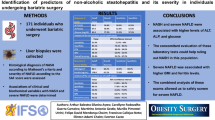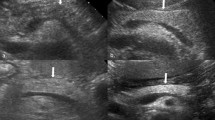Abstract
Background
Nonalcoholic fatty liver disease (NAFLD) and gallstone disease (GD) share common risk factors. There are no firm recommendations regarding screening of NAFLD in patients at risk. Our aim was to assess the prevalence of and factors associated with NAFLD in a cohort of patients operated for symptomatic GD and evaluate the usefulness of routine liver biopsy.
Methods
Ninety-five consecutive patients underwent a liver biopsy at the end of a standard laparoscopic cholecystectomy for symptomatic GD. Clinical, biochemical, demographic, and anthropometric variables were obtained prospectively.
Results
Fifty-two patients (55%) had biopsies compatible with NAFLD. These patients were classified according to the system proposed by Brunt et al. as follows: grade I, n = 27 (52%); grade II, n = 15 (29%); grade III, n = 10 (19%). Two grade III patients had zone III focal perisinusoidal fibrosis and three had overt cirrhosis. Only 13% of subjects had a suspected diagnosis of NAFLD preoperatively. In multivariate logistic regression, only obesity was significantly associated with NAFLD. There were no complications or mortality.
Discussion
Fifty-five percent of patients with GD have associated NAFLD. Awareness of this association may result in an earlier diagnosis. The high prevalence of NAFLD in patients with GD may justify routine liver biopsy during cholecystectomy to establish the diagnosis, stage, and possible direct therapy.
Similar content being viewed by others
References
Szczepaniak LS, Nurenberg P, Leonard D, Browning JD, Reingold JS, Grundy S, et al. Magnetic resonance spectroscopy to measure hepatic triglyceride content: prevalence of hepatic steatosis in the general population. Am J Physiol Endocrinol Metab 2005;2:E462–468. doi:10.1152/ajpendo.00064.2004.
Perlemuter G, Bigorgne A, Cassard-Doulcier AM, Naveau S. Nonalcoholic fatty liver disease: from pathogenesis to patient care. Nat Clin Pract Endocrinol Metab 2007;6:458–469. doi:10.1038/ncpendmet0505.
Guha IN, Parkes J, Roderick PR, Harris S, Rosenberg WM. Non-invasive markers associated with liver fibrosis in non-alcoholic fatty liver disease. Gut 2006;1:1650–1660. doi:10.1136/gut.2006.091454.
Adams LA, Angulo P. Role of liver biopsy and serum markers of liver fibrosis in non-alcoholic fatty liver disease. Clin Liver Dis 2007;1:25–35. doi:10.1016/j.cld.2007.02.004.
Diehl AK, Haffner SM, Hazuda HP, Stern MP. Coronary risk factors and clinical gallbladder disease: an approach to the prevention of gallstones? Am J Public Health 1987;77:841–845.
Katsika D, Tuvblad C, Einarsson C, Lichtenstein P, Marschall HU. Body mass index, alcohol, tobacco and symptomatic gallstone disease: a Swedish twin study. J Intern Med 2007;262:581–587. doi:10.1111/j.1365-2796.2007.01860.x.
Méndez-Sánchez N, Bermejo-Martínez LB, Viñals Y, Chavez-Tapia NC, Vander Graff I, Ponciano-Rodríguez G, et al. Serum leptin levels and insulin resistance are associated with gallstone disease in overweight subjects. World J Gastroenterol 2005;11:6182–6187.
Olokoba AB, Bojuwoye BJ, Olokoba LB, Braimoh KT, Inikori AK. Gallstone disease and type-2 diabetes mellitus—the link. J Coll Physicians Surg Pak 2007;17:594–597.
Loria P, Lonardo A, Lombardini S, Carulli L, Verrone A, Ganazzi D, et al. Gallstone disease in non-alcoholic fatty liver: prevalence and associated factors. J Gastroenterol Hepatol 2005;8:1176–1184. doi:10.1111/j.1440-1746.2005.03924.x.
Nervi F, Miquel JF, Alvarez M, Ferreccio C, García-Zattera MJ, González R, et al. Gallbladder disease is associated with insulin resistance in a high risk Hispanic population. J Hepatol 2006;2:299–305. doi:10.1016/j.jhep.2006.01.026.
Méndez-Sánchez N, Chavez-Tapia NC, Motola-Kuba D, Sanchez-Lara K, Ponciano-Rodríguez G, Baptista H, et al. Metabolic syndrome as a risk factor for gallstone disease. World J Gastroenterol 2005;11:1653–1657.
Shaffer EA. Epidemiology and risk factors for gallstone disease: has the paradigm changed in the 21st century? Curr Gastroenterol Rep 2005;2:132–140. doi:10.1007/s11894-005-0051-8.
Brunt EM, Janney CG, Di Bisceglie AM, Neuschwander-Tetri BA, Bacon BR. Nonalcoholic steatohepatitis: a proposal for grading and staging the histological lesions. Am J Gastroenterol 1999;94:2467–2474. doi:10.1111/j.1572-0241.1999.01377.x.
Friedman GD, Kamel WB, Dawber TR. The epidemiology of gallbladder disease: observations in the Framingham study. J Chronic Dis 1996;19:273–292. doi:10.1016/0021-9681(66)90132-9.
Heaton KW, Braddon FEM, Emmett PM, Mountford RA, Hughes AP, Bolton CH, et al. Why do men get gallstones? Roles of abdominal fat and hyperinsulinaemia. Eur J Gastroenterol Hepatol 1991;3:745–751.
De Santis A, Attili AF, Ginanni Corradini S, Scafato E, Cantagalli A, De Luca C, et al. Gallstones and diabetes: a case-control study in a freeliving population sample. Hepatology 1997;25:787–790. doi:10.1002/hep.510250401.
Tsai CJ, Leitzmann MF, Willett WC, Giovannucci EL. Prospective study of abdominal adiposity and gallstones in US men. Am J Clin Nutr 2002;40:937–943.
Shaffer EA. NASH: non-alcoholic steatohepatitis. Can J Gastroenterol 2002;16:318–321.
Diehl AK. Cholelithiasis and the insulin resistance syndrome. Hepatology 2000;31:528–530. doi:10.1002/hep.510310238.
Gulsen M, Yesilova Z, Bagci S, Uygun A, Ozcan A, Ercin CN, et al. Elevated plasma homocysteine concentrations as a predictor of steatohepatitis in patients with non-alcoholic fatty liver disease. J Gastroenterol Hepatol 2005;9:1448–1455. doi:10.1111/j.1440-1746.2005.03891.x.
Roblin X, Pofelski J, Zarski JP. Steatosis, chronic hepatitis virus C infection and homocysteine. Gastroenterol Clin Biol 2007;4:415–420. doi:10.1016/S0399-8320(07)89402-4.
Sanyal AJ, Campbell-Sargent C, Mirshahi F, Rizzo WB, Contos MJ, Sterling RK, et al. Nonalcoholic steatohepatitis: association of insulin resistance and mitochondrial abnormalities. Gastroenterology 2001;120:1183–1192. doi:10.1053/gast.2001.23256.
Sazci A, Ergul E, Aygun C, Akpinar G, Senturk O, Hulagu S. Methylenetetrahydrofolate reductase gene polymorphisms in patients with nonalcoholic steatohepatitis (NASH). Cell Biochem Funct 2008;3:291–296. doi:10.1002/cbf.1424.
Wanless IR, Lentz JS. Fatty liver hepatitis (steatohepatitis) and obesity: an autopsy study with analysis of risk factors. Hepatology 1990;12:1106–1110. doi:10.1002/hep.1840120505.
van der Linden W. Genetic factors in gallstone disease. Clin Gastroenterol 1973;2:603–614.
Méndez-Sánchez N, King-Martínez AC, Ramos MH, Pichardo-Bahena R, Uribe M. The Amerindian’s genes in the Mexican population are associated with development of gallstone disease. Am J Gastroenterol 2004;99:2166–2170. doi:10.1111/j.1572-0241.2004.40159.x.
Diehl AK, Stern MP. Special health problems of Mexican–Americans: obesity, gallbladder disease, diabetes mellitus, and cardiovascular disease. Adv Intern Med 1989;34:73–96.
Wagener DK, McDonald M. Increased gallbladder-related mortality among Hispanics: does education play a role? Ethn Health 1996;1:197–205.
Reid KM, Ramos-De la Medina A, Donohue JH. Diagnosis and surgical management of gallbladder cancer: a review. J Gastrointest Surg 2007;11:671–681. doi:10.1007/s11605-006-0075-x.
Lisker R, Perez-Briseno R, Granados J, Babinsky V. Gene frequencies and admixture estimates in four Mexican urban centers. Hum Biol 1990;62:791.
Mofrad P, Contos MJ, Haque M, Sargeant C, Fisher RA, Luketic VA, et al. Clinical and histologic spectrum of nonalcoholic fatty liver disease associated with normal ALT values. Hepatology 2003;37:1286–1292. doi:10.1053/jhep.2003.50229.
Bianchi L. Liver biopsy in elevated liver functions tests? An old question revisited. J Hepatol 2001;35:290–294. doi:10.1016/S0168-8278(01)00155-6.
Abdi W, Millan JC, Mezey E. Sampling variability on percutaneous liver biopsy. Arch Intern Med 1979;139:667–669. doi:10.1001/archinte.139.6.667.
Ratziu V, Charlotte F, Heurtier A, Gombert S, Giral P, Bruckert E, LIDO Study Group, et al. Sampling variability of liver biopsy in nonalcoholic fatty liver disease. Gastroenterology 2005;7:1898–1906. doi:10.1053/j.gastro.2005.03.084.
Merriman RB, Ferrell LD, Patti MG, Weston SR, Pabst MS, Aouizerat BE, et al. Correlation of paired liver biopsies in morbidly obese patients with suspectedvnonalcoholic fatty liver disease. Hepatology 2006;4:874–880. doi:10.1002/hep.21346.
Padoin AV, Mottin CC, Moretto M, Berleze D, Kupski C, Glock L, et al. A comparison of wedge and needle hepatic biopsy in open bariatric surgery. Obes Surg 2006;16:178–182. doi:10.1381/096089206775565159.
Imamura H, Kawasaki S, Bandai Y, Sanjo K, Idezuki Y. Comparison between wedge and needle biopsies for evaluating the degree of cirrhosis. J Hepatol 1993;17:215–219. doi:10.1016/S0168-8278(05)80041-8.
Younossi ZM, Gramlich T, Liu YC, Matteoni C, Petrelli M, Goldblum J, et al. Nonalcoholic fatty liver disease: assessment of variability in pathologic interpretations. Mod Pathol 1998;11:560–565.
Author information
Authors and Affiliations
Corresponding author
Additional information
Discussion
Michael G. Sarr, M.D. (Rochester, MN): I have three questions. First, this is in a Mexican population, and so how representative of the rest of the genomic world is it? Second, if you find somebody with fatty liver disease, how are you going to treat them? I don’t know of many effective therapies for NAFLD. And third, can you select out the patients whom you should biopsy? So if they are skinny and they don’t have any other of these risk factors, do you need to biopsy them as well?
Jose M. Remes-Troche, M.D. (Veracruz, Mexico): Thank you for your questions. The first question, I think it is very important to remark that in many liver and gallstones diseases, ethnicity has a key role. There are several studies that have shown that gallstone disease is more prevalent in some Latin American countries and in some populations like Hispanics and Native American Indians. Thus, our study is just representative of our population. We believe that further studies regarding ethnicity and genomic issues are required, trying to look for which genes could be related to predicting and try to see if this is the same phenomenon in other populations.
Regarding the second question, one of the main problems that actually we have as a physician is the lack of a gold standard treatment for NAFLD. However, several recent studies have shown that in NAFLD, morbidity and mortality related to liver disease, but mainly to coronary artery disease, is considerably higher. So even if we don’t have good medical treatment, we believe that reinforcement of changes in lifestyle, such as exercise and weight loss, are extremely important in these patients. It was surprising for us that three patients without any other apparent risk factors for fibrosis were diagnosed with early stage liver cirrhosis. This observation is very important because, besides the gallstones disease, the patients were consider as otherwise “healthy” subjects.
And regarding your third question?
Dr. Sarr: Can you select out the patients whom you should biopsy?
Dr. Remes-Troche: Yes. One of the messages of this study is that patients with gallstones diseases and NAFLD have some preoperative risks factors associated such as dyslipidemia, diabetes, and obesity. Thus, at least in our population, recognition of these risk factors could help to select patients. Also, this information is useful to let know patients the importance of take a liver biopsy during the cholecystectomy.
Rights and permissions
About this article
Cite this article
Ramos-De la Medina, A., Remes-Troche, J.M., Roesch-Dietlen, F.B. et al. Routine Liver Biopsy to Screen for Nonalcoholic Fatty Liver Disease (NAFLD) during Cholecystectomy for Gallstone Disease: Is it Justified?. J Gastrointest Surg 12, 2097–2102 (2008). https://doi.org/10.1007/s11605-008-0704-7
Received:
Accepted:
Published:
Issue Date:
DOI: https://doi.org/10.1007/s11605-008-0704-7




